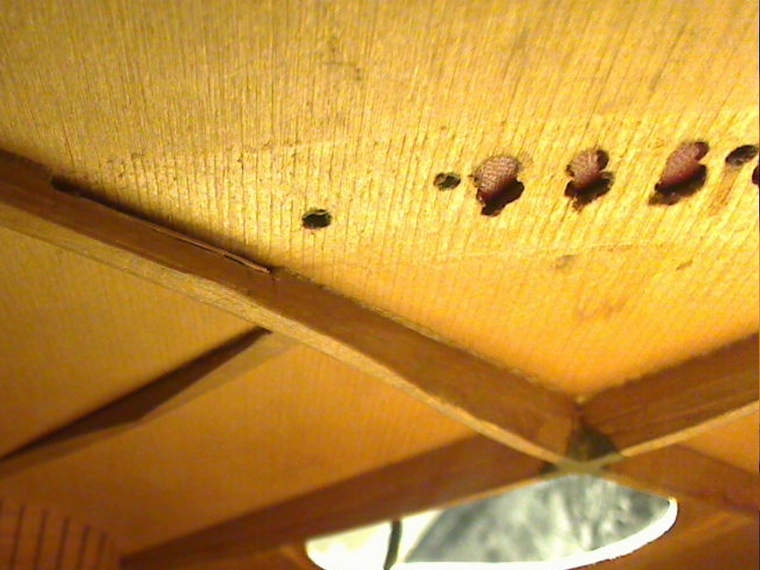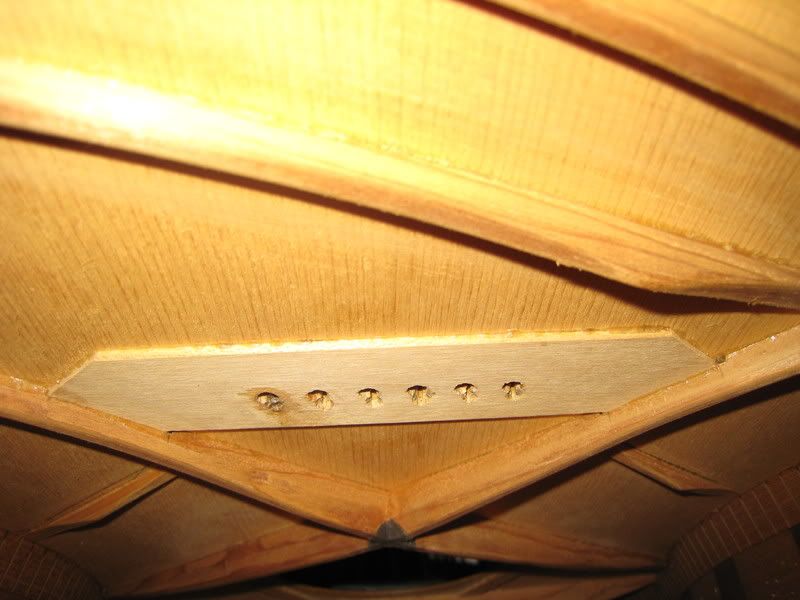
1927 00-28



1933 00-18

Here's a 1934 00-40H:


A tracing from a 1935 00-21:

According to http://www.provide.net/~cfh/martin.html the cross of the x-brace moved farther from the soundhole late in 1938. In the above examples the x is one inch from the soundhole and below, it is farther than one inch.
Also, according to the same source, "the tone bars were angled more parallel with the length of the guitar and further apart. These late-1938 to late-1944 guitars had deeper scalloped braces than the 1938 and prior forward or advanced braced guitars."
1938 00-18


1940 00-18




1941


Here are plans for a Martin-style 00. Specifically which year, or era, is not yet determined.
The following information about back braces comes from John Arnold:
Upper back braces width x height.
1/4" x 1/2".
Lower back braces width x height.
3/4" x 5/16".
After looking at some measurements, I think that the nominal height was 3/8, but some of them have measured as low as 0.320" (basically 5/16"). I have never seen any that were 1/4" high. In general, the #3 brace is a bit lower than #4.
Some of the confusion may arise because those braces are so rounded that getting an accurate measurement of height can be tricky, especially through the soundhole.
My best measurements came from OM's where the back had been removed for repair.....a 1929 OM-28, a 1930 OM-28, and a 1932 OM-18.
The tall #1 and #2 braces should be about 0.120" and the flat braces about 0.090".
And then this info comes from Willi Henkes:
Back braces on a 1935 00-21:
7 x 13 mm
7 x 12 mm
19 x 9 mm
19 x 9 mm
0.275" x 0.512"
0.275" x 0.472"
0.748" x 0.354"
0.748" x 0.354"
Measurements from a 1935 D-18, done by John Arnold:
Bass X minimum = 0.320
Bass X peak = 0.435, 6 5/16 from center of the X crossing
Treble X minimum = 0.300
Treble X peak = 0.565, 5 15/16 from center of the X crossing
(and Henk adds, "The height at the X is not mentioned here, but that would typically be about 5/8"")
This info about bridge plates comes from http://www.provide.net/~cfh/martin.html
1932: bridgeplate were enlarged from 1" to 1 3/8" on all belly bridge styles (style 18 and higher). Style 17 (mahogany top) models that didn't get a belly bridge stayed with the smaller 1" bridge plate.
Upper back braces width x height.
1/4" x 1/2".
Lower back braces width x height.
3/4" x 5/16".
After looking at some measurements, I think that the nominal height was 3/8, but some of them have measured as low as 0.320" (basically 5/16"). I have never seen any that were 1/4" high. In general, the #3 brace is a bit lower than #4.
Some of the confusion may arise because those braces are so rounded that getting an accurate measurement of height can be tricky, especially through the soundhole.
My best measurements came from OM's where the back had been removed for repair.....a 1929 OM-28, a 1930 OM-28, and a 1932 OM-18.
The tall #1 and #2 braces should be about 0.120" and the flat braces about 0.090".
And then this info comes from Willi Henkes:
Back braces on a 1935 00-21:
7 x 13 mm
7 x 12 mm
19 x 9 mm
19 x 9 mm
0.275" x 0.512"
0.275" x 0.472"
0.748" x 0.354"
0.748" x 0.354"
Measurements from a 1935 D-18, done by John Arnold:
Bass X minimum = 0.320
Bass X peak = 0.435, 6 5/16 from center of the X crossing
Treble X minimum = 0.300
Treble X peak = 0.565, 5 15/16 from center of the X crossing
(and Henk adds, "The height at the X is not mentioned here, but that would typically be about 5/8"")
This info about bridge plates comes from http://www.provide.net/~cfh/martin.html
1932: bridgeplate were enlarged from 1" to 1 3/8" on all belly bridge styles (style 18 and higher). Style 17 (mahogany top) models that didn't get a belly bridge stayed with the smaller 1" bridge plate.
Here's a full bracing chronology from the same source:
- 1840s to 1938: Scalloped "X" bracing, position of the cross of the "X" bracing one inch from edge of soundhole, aka "forward braced" or "advanced bracing".
- 1927: bracing dimensions and top thickness increases to accomodate steel strings. Note this is not a "for sure" rule.
- Late 1938: Scalloped "X" bracing with "rear shifted bracing", where position of the "X" moved further than one inch from soundhole (exact measurement varies, for example: a 1941 D-18 has 1 7/8" distance). So the X-braces were moved about 7/8" further down. And the tone bars were angled more parallel with the length of the guitar and further apart. These late-1938 to late-1944 guitars had deeper scalloped braces than the 1938 and prior forward or advanced braced guitars. This gives the late 1938 to late 1944 Martin guitars improved bass response (don't let anyone tell you that war-time Martins are not as good as pre-1939 Martins!)
- mid-1939 Popscicle bracing on D body sizes. See the above picture for what the popsicle or T-6 or upper transverse graft brace is. The popsicle brace was added to the underside of the top of the guitar, below the fingerboard. The brace was added to help prevent top cracks alongside the fingerboard. Since the first D body size was made in about 1934, problems obviously came about and Martin added the brace by 1939. The brace does not appear in pre-1939 Martin D-sizes, but transitioned in around 1939, and is present in all 1940 and later D models. Without the popsicle brace, the top is attached only by the strength of the spruce fibers and a 1/2" x 2" glue area where the top overlays the soundhole #1 brace. With the popsicle brace there is an additional 1" x 2" glue surface directly under the fingerboard. Unfortunately the popsicle brace can deaden the sound of the upper bout area of the soundboard, and the popsicle brace doesn't always prevent the top from cracking along the fingerboard either. As people search for why the old Martins sound so good, they examine every aspect of them and the popsicle brace usually enters the conversation. Here's some data on popsicle braces:
1938 D-18 #71539 rear-shifted X-brace, no popsicle brace.
1939 D-28 #71968 rear-shifted X-brace, no popsicle brace.
1939 D-18 #72618 1 3/4" neck width, no popsicle brace.
1939 D-18 #72702 1 3/4" neck width, popsicle brace (stamp 23 May 1939).
All 12 fret Martins have the popscicle stick brace too. - 1939: The #1 brace inside near the neck block changes from 5/16" wide to 1/2" wide, making it roughly twice as wide. This happened at the same time as the popscicle brace addition. The neck block thickness was also reduced by 1/4". About the same time beck width reduced from 1 3/4" to 1 11/16" at the nut, and the bridge spacing reduced from 2 5/16" to 2 1/8".
- Late 1944: According to Martin, the last scalloped braced Martin in late 1944 was approximately serial number 89926. Though some models have been seen after this number with scalloped braces, and before this number with tapered braces. (For example #90014 appears to be the last D28 with scalloped braces, and D-28 #88112 had tapered braces.)
- Late 1944 to 1976: Heavy straight "X" bracing (not scaloped), position of the "X" still further than one inch from soundhole (exact measurement varies, for example: a 1958 000-18 has 1 3/4" distance, and a 1967 000-28 has 1 13/16" distance).
- Late 1944 to about 1949: the bracing was tapered. This stopped in the late 1940s, and was a progressive thing. So unlike scaloped bracing that had a definate endpoint, tapered braces evoloved into "straight" braces by 1949. This is why 1945-1949 Martins are still highly regarded as "better" than their 1950s counterparts, but not as good as the 1944 and prior scalloped braced guitars.
- 1948: Bridgeplates are no longer notched into the X-braces.
- 1949-1976: Straight braces (neither scalloped or tapered.)
- Circa 1960: X-bracing moves back up to 1 1/2" from soundhole.
- 1964: Hot hide glue phased out with the move to the new factory. Hot hide glue continued to be used to attach the top to the body.
- 1968: Small maple bridgeplate (1 3/8") replaced by small rosewood bridgeplate.
- 1969: Small rosewood bridgeplate replaced with large rosewood bridgeplate (3 1/4").
- 1976 to present: Scalloped bracing re-introduced on some models (HD-28, D-45 in 1985, D-41 in 1987). Also one inch "X" bracing used again in the late 1980s on many "D" models.
Tim L @ OLF says on his Martin '33 OM, "the size of the X braces at the intersection is .280 x .650. The rest of the bracing is 1/4"."
Henk @ UMGF says, "000's have 5/16" wide bracing, while 00's have 1/4". 00's traditionally have X braces 9/16" tall."
"Some [UMGF] members who have inquired about a custom 14-fret 00, were told by Martin that shifting forward is not possible. I wonder why that is. Perhaps it's a practical thing that has to do with existing jigs and setup. However, from what I've heard, some were told that shifting forward was physically not possible as for instance it would make the X-arms end up in the upper transverse brace. That certainly is not the case."
1932 0-17: braces are 1/4, scalloped, 12 frets 0 should have one tone brace only... maybe I got an odd number. The transverse brace is 1/4 also, tappered. 19 frets total.
1933 0-17: braces are 1/4, scalloped, transverse brace as well but tappered. The bridge is not original, I can't tell if the 'wide' bridge plate is. 20 frets total.
1962 0-16NY: all braces are 1/4 (transverse brace is half way between 7/16 and 1/2"), X braces are straight with the ends tappered, the tone brace and the finger braces are tappered toward the X braces and heavily scalloped toward the body. The diamonds size and position are approximative. 19 frets total.
The X legs angle is 98° on the three guitars
Metropo @ UMGF:
Also, being "00" size top braces, they are shorter....9/16" vs. 5/8". The reduction in height is more important, since stiffness is proportional to the cube. That means that 9/16" tall braces are 37% less stiff than those that are 5/8" tall. OTOH, stiffness is directly proportional to the width, so 1/4" wide bracing is 20% less stiff than 5/16".
The height/cube relationship is the reason that scalloping braces changes the sound so dramatically, and the reason that many amateurs scallop too much. A few thousandths of an inch can make a world of difference.
John Arnold:
"The braces were moved back on the 14-fret 0's and 00's around 1935. Only the 14-fret 000's and dreadnoughts moved in late 1938."
Here for comparison's sake is a 1957 00-18

And here are some general pictures of bracing in non-00 pre-war Martins.
1928 000-28

1931 OM-18








1931 OM-28

1936 D-18




And an example of "tucked" braces:

No comments:
Post a Comment